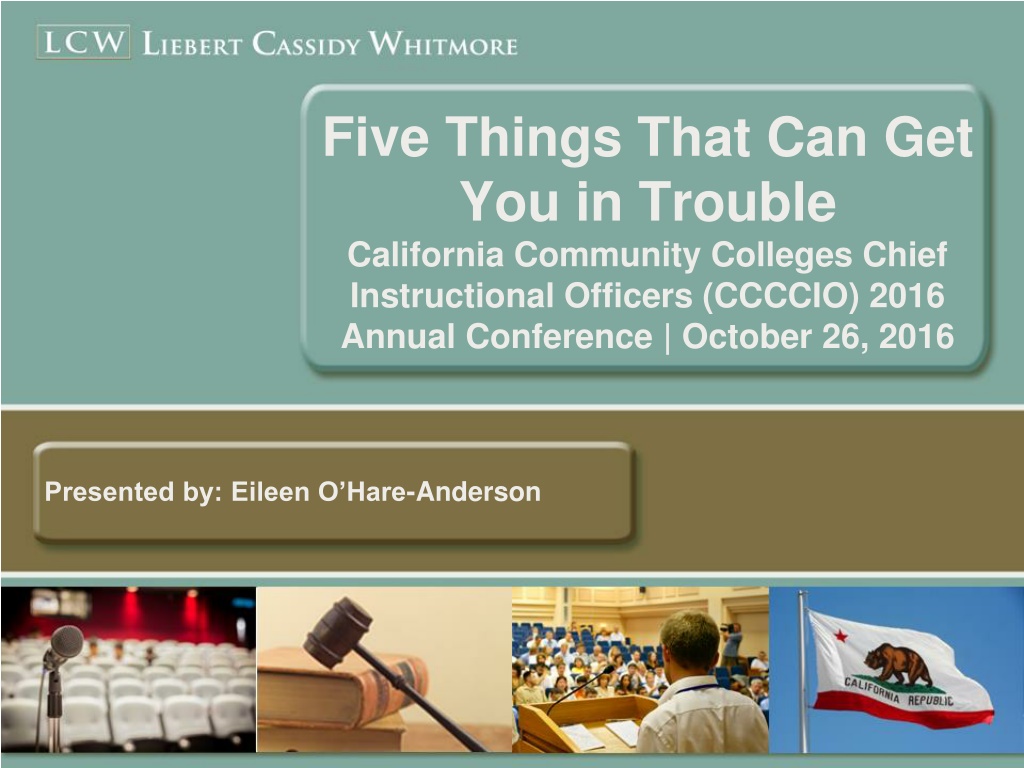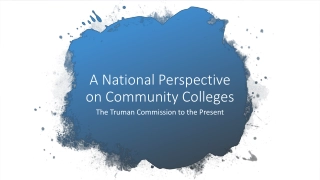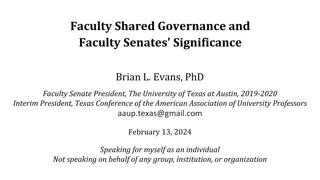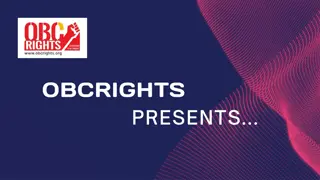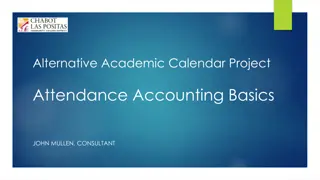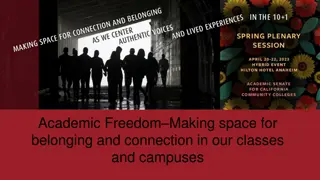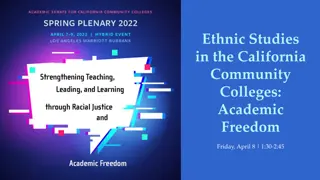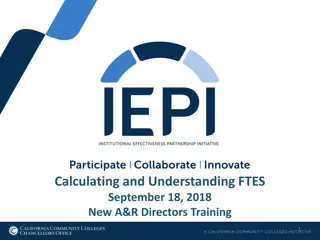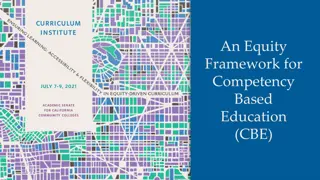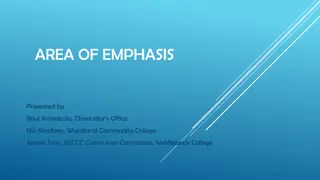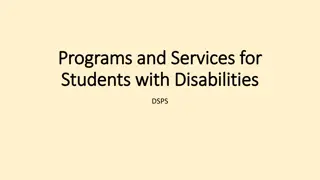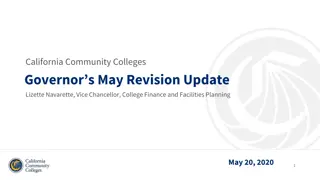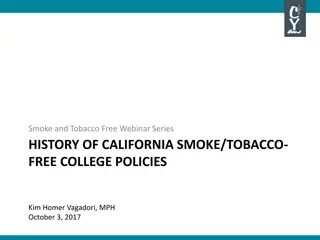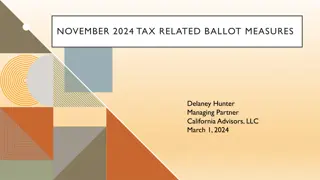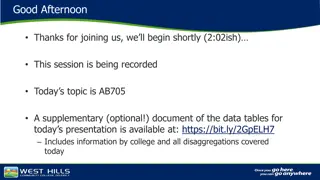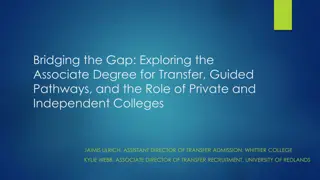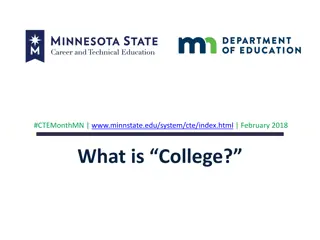Understanding Faculty Obligation Number (FON) in California Community Colleges
Exploring the complexities of Faculty Obligation Number (FON) in California Community Colleges through topics discussed at the CCCCIO 2016 Annual Conference. The presentation covers important aspects such as the 50% Law, the role of counselors in teaching Guidance Studies courses, and the regulations surrounding FON as a planning tool for hiring faculty. Delve into the essential knowledge required for Chief Instructional Officers in managing educational compliance effectively.
Download Presentation

Please find below an Image/Link to download the presentation.
The content on the website is provided AS IS for your information and personal use only. It may not be sold, licensed, or shared on other websites without obtaining consent from the author. Download presentation by click this link. If you encounter any issues during the download, it is possible that the publisher has removed the file from their server.
E N D
Presentation Transcript
Five Things That Can Get You in Trouble California Community Colleges Chief Instructional Officers (CCCCIO) 2016 Annual Conference | October 26, 2016 Presented by: Eileen O Hare-Anderson
Topics FON 50% Law Community and Contract Education What Is It? Title 5, Ed Code, or Urban Legend? What is the Legislative and Regulatory Process How Do They Change Ed Code and Title 5? How Do We Find Out? HR for CIOs 2
Quiz #1 Why do we have counselors teach a Guidance Studies course or two each semester? Because we re mean administrators. Because students need GS courses. Because students love them. All of the above. None of the above. 3
The 50% Law 50% of the budget: Current expense of education. Used for instructor salaries. K-12 holdover: Makes lots more sense in the K12 system. Arcane but its still there. 4
The 50% Law Salaries of Classroom Instructors. Includes all benefit costs. Full and part time instructors: Academic position. Teaches at least one instructional period each day employed . Classified employees: Instructional aide or similar title; and Work under instructor s general direction. CAUTION HERE! Education Code, 84362, subd. (a) and (b); Title 5, 59204, subd. (a); 5
Quiz #2 TRUE, FALSE, MAYBE The Faculty Obligation Number is not my problem. It s HR s problem. 6
Quiz #2a TRUE, FALSE, MAYBE Computing the FON is a complex formula, involving crystal balls and reading chicken entrails. 7
Faculty Obligation Number FON is the base number of FTF. Increase FTF over last year. In same proportion as growth in credit FTES. Chancellor s Office gives us the number. There are regulations regarding the formula. There are penalties for non-compliance. Title 5, 51025 8
Faculty Obligation Number Use the FON as a planning tool. How many additional FTF to hire? Where to put them? 9
Quiz #3 True False Maybe We can claim apportionment for courses that are not open to the public. 10
Contract Education Contract for instructional classes. At request of public or private groups. Must recover all costs. Cannot claim apportionment since courses are not open to general student population. Education Code, 78021; Title 5, 58051.5 11
Contract Education District can contract to meet specific educational and training needs: Public or private agencies; Corporations; Associations; Any other person or body. Can be credit, non-credit, not-for-credit. Education Code, 78020, 78021 12
Contract Education How do we load these courses? Credit and non-credit count toward load. Not-for-credit do not count toward load. What about MQs? Credit and non-credit faculty must meet MQs. Not-for-credit do not have MQs. 13
Quiz #4 True False Maybe Yoga, MS Word, ukulele, interior decorating, estate planning, quilting, and selling on eBay as courses have no place in a community college. 14
Community Education Self-supporting, fee-based courses. Open to adults and minors. Contribute to physical, mental, moral, economic, or civic development. Establish and maintain in: Civic, vocational, literacy, health, homemaking, technical and general education. Education Code section 78300; Title 5, 55002, subd. (d) and 55160 15
Community Education Cannot expend general funds. Charge student fee not exceeding class maintenance cost; or Remuneration by contract; or Group or individual donation or contribution. These courses are: Cake decorating, MS Word, ukulele, interior decorating, estate planning, quilting, selling on eBay, wine tasting, Asian cooking, bee keeping, stained glass, swing dancing, yoga, crochet, travel, yoga, car maintenance, conversational Spanish. 16
What is the Education Code and What is Title 5?
Quiz #5 TRUE, FALSE, MAYBE Entry into the Education Code is painful. 18
Education Code Entry into the Education Code is painful. Haase v. San Diego Community College District Ed Code is enacted by State Legislature. One of 29 codes. Is the state law: Applies to K12, CCD, UC (some), CSU, some private schools. 19
Quiz #6 How many other codes can you name? 20
California Codes Business and Professions Civil Code of Civil Procedure Commercial Corporations Elections Evidence Family Financial Fish and Game Food and Agricultural Government Harbors and Navigation Health and Safety Insurance Labor Military and Veterans Penal Probate Public Contract Public Resources Public Utilities Revenue and Taxation Streets and Highways Unemployment Insurance Vehicle Water Welfare and Institutions 21
Education Code Enacted by the state legislature. Amended by the legislature. Assembly bills and senate bills: AB or SB; Signed by Governor. Happens all year long. But there is a rush in September every year. Usually effective January 1. Problem: Legislature only thinks it knows the Ed Code. 22
Quiz #7 True False Maybe There is one title of regulations for every code. 23
Title 5 Regulations are enacted by state agencies. In our case the State Chancellor s Office. To implement statutes: Think: difference between Board Policy and Administrative Procedures. With the community colleges: Title 5 regulations clarify and define. How to apply a statute. 24
Title 5 Drafted by staff at CCCCO. Then to Consultation Council. BOG acts: Two-reading process. Then goes to Department of Finance. Then to the Office of Administrative Law. Then published and effective. CCCCO sends notices to its lists : Before 1st and 2d readings. 25
What Happens when Ed Code and Title 5 are in Conflict??
Which Prevails? Statute passed by the legislature. Signed by the governor. Regulations by a state agency. Through state bureaucracy. Statute trumps. 27
Ed Code, Title 5, or Urban Legend?
Quiz #8 Ed Code, Title 5, Urban Legend True, False, Maybe A Faculty member must have line-of-sight supervision of students at all times. 29
Ed Code, Title 5, or Urban Legend To claim apportionment for a course. Immediate supervision and control of academic employee. Authorized to render service; Requires the presence of the academic employee. Employee not required to render other service at the time. Title 5, 58056 30
Quiz #9 Ed Code, Title 5, Urban Legend True, False, Maybe The Board must approve all out of state travel. 31
Ed Code, Title 5, or Urban Legend Many districts require this in their board policies, or admin procedures. It is not in Ed Code or Title 5. 32
Quiz #10 Ed Code, Title 5, Urban Legend True, False, Maybe We can average part-time adjunct faculty member s load over the two semesters in the academic year to keep him/her under 67%. 33
Ed Code, Title 5, or Urban Legend Generally, not. The only time you can do this is when you have someone on a firm, year- long contract. That s relatively rare. Make sure you work with HR and your lawyer if you want to do this. Tread very carefully. Rooney v. San Diego CCD 34
Quiz #11 Ed Code, Title 5, Urban Legend True, False, Maybe Adjunct employees can start working without any paperwork as long as they meet MQs. 35
Ed Code, Title 5, or Urban Legend Absolutely not. We must provide notice to temps. Before the first date of paid service: Temporary nature of employment. Salary. If no written notice then presumed probationary. What happens to probes after four years? Ed Code 87477 36
Quiz #12 Ed Code, Title 5, Urban Legend True, False, Maybe If a classified employee is out on extended sick leave, we can extend their probationary period. After all, we didn t get to evaluate their performance. 37
Ed Code, Title 5, or Urban Legend This is pure urban legend. In fact, if you do this, you will own the classified employee. Different answer in merit systems. Different analysis completely for faculty. 38
Discipline and Performance Documentation
Quiz #13 We can take any of the following actions against an employee who has no prior disciplinary incidents: Written Letter of Reprimand. Suspension. Termination. None of the above. All of the above. 41
Quiz #13a True False Maybe Why are you spending time on this? Successful discipline of a public employee is like an albino flamingo. 42
Progressive Discipline Goal is improved performance. Key to sustaining is good documentation: It s not truth it s proof. What s in the personnel file? Don t be afraid of it. It requires diligence. It s possible. 43
Progressive Discipline Counseling Oral Reprimand Written Reprimand Reduction in pay (where negotiated) Suspension Demotion (where negotiated) Demotion Discharge 44
Employee Discipline Documentation is the key. It is almost impossible to be too specific in LOR or evaluation. Process matters must follow rules. Work with HR! Don t get ahead of the process. The tale of the camel s back. 45
Employee Discipline Process must follow rules. Classified: Generally in the CBA. Academic: Driven by the Ed Code. Work with HR. Don t be a cowboy. 46
Quiz #14 The FMLA defines a serious health condition as: 3 days of incapacity. 2 visits to a health care provider within 30 days. A visit to a health care provider that occurs within 7 days of the incapacity. All of the above. 48
Quiz #14a What on earth is the FMLA? 49
Available Leaves for Educational Employees Sick Leave Extended Leave Personal Necessity Discretionary Leave Industrial Injury Leave Catastrophic Leave Sabbatical Leave Military Leave Kin Care Leave Pregnancy Disability Disability Leave Family School Leave Voting Leave Court Leave Victim Leaves FMLA/CFRA 50
